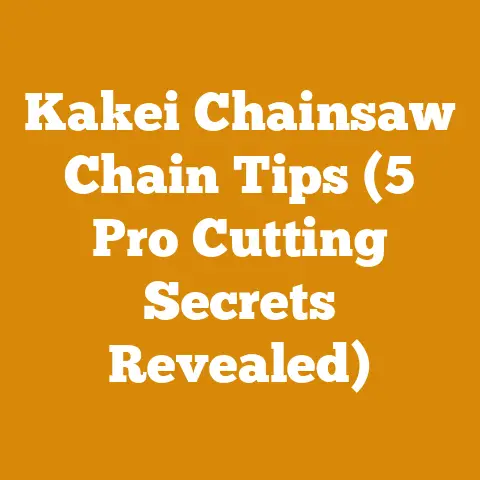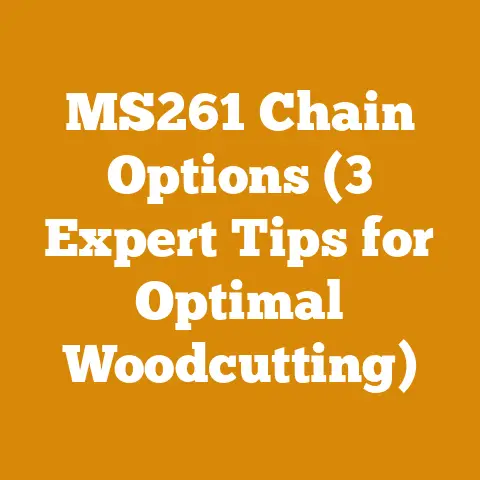Stump Grinding Business for Sale: 7 Lessons from My First Machine (Pro Insights)
The smell of freshly ground wood still lingers in my memory, a potent mix of earth and sawdust that instantly transports me back to my early days in the stump grinding business. It wasn’t just a job; it was a baptism by fire, a crash course in entrepreneurship, and a gritty introduction to the world of wood processing. I remember the thrill of firing up my first machine, a beast of metal and teeth, and the satisfaction of watching stubborn stumps disappear, leaving behind smooth, usable earth. Now, as I prepare to sell that very business, I want to share the lessons I’ve learned – the hard-won wisdom that can help anyone considering stepping into this niche. This isn’t just about buying a business; it’s about understanding the realities, the challenges, and the immense potential of transforming unwanted stumps into opportunity.
Stump Grinding Business for Sale: 7 Lessons from My First Machine (Pro Insights)
The stump grinding business, while seemingly straightforward, is a dynamic field that demands a blend of technical skill, business acumen, and a healthy dose of resilience. It’s more than just wielding a powerful machine; it’s about understanding wood types, soil conditions, customer needs, and the intricate dance of running a profitable operation. I’ve distilled my experiences into seven key lessons that I believe are crucial for success.
1. Know Your Machine: The Heart of Your Operation
My first stump grinder wasn’t the fanciest model on the market, but it was mine. It was a mid-sized, self-propelled machine with a respectable horsepower rating. I quickly learned that understanding its capabilities and limitations was paramount.
- Horsepower vs. Stump Size: A common misconception is that more horsepower automatically equates to faster grinding. While horsepower is essential, it’s the efficient use of that power that truly matters. I found that matching the machine’s horsepower to the average stump size in my service area was more cost-effective than investing in an oversized grinder for occasional large stumps. For instance, in my area, most stumps were under 24 inches in diameter. A 25-horsepower machine proved ideal, handling these stumps efficiently without excessive fuel consumption. Larger stumps (30+ inches) were less frequent and could be tackled with patience or subcontracted out.
- Cutter Teeth: The Business End: The teeth are the grinder’s contact point with the wood, and their condition directly impacts performance. I experimented with different tooth types (carbide-tipped, steel) and quickly realized that carbide-tipped teeth, while more expensive upfront, lasted significantly longer and maintained their sharpness. This translated to less downtime for tooth replacement and improved grinding speed. I tracked my tooth replacement costs meticulously, finding that carbide teeth reduced my annual tooth expense by approximately 40% compared to steel teeth.
- Maintenance is King: Preventative maintenance is the unsung hero of any successful stump grinding operation. Neglecting routine maintenance can lead to costly repairs and lost revenue. I established a strict maintenance schedule, including daily checks of fluid levels, belt tension, and tooth condition. I also performed regular greasing of bearings and lubrication of moving parts. This proactive approach minimized breakdowns and extended the lifespan of my machine. I remember one instance where I ignored a slightly loose belt. The belt eventually snapped mid-job, costing me a half-day of work and a service call. That was a lesson I never forgot.
Data Point: I kept detailed records of all maintenance activities, including parts replaced, labor hours, and associated costs. This data allowed me to identify recurring issues, optimize my maintenance schedule, and accurately predict future repair expenses. It also proved invaluable when negotiating the sale of my business, demonstrating the well-maintained condition of the equipment.
2. Understanding Wood: Not All Stumps Are Created Equal
Before I started, I thought all wood was pretty much the same when it came to grinding. Boy, was I wrong! Different wood species react differently to the grinder, impacting both the speed and efficiency of the process.
- Hardwoods vs. Softwoods: Hardwoods, like oak and maple, are denser and more resistant to grinding than softwoods like pine and fir. Grinding hardwoods requires sharper teeth and more power. Softwoods, on the other hand, tend to produce more sawdust and can clog the machine if not properly managed.
- Wood Decay: The condition of the wood also plays a significant role. Decayed wood is easier to grind but can be messy, producing a slurry of rotting material. Freshly cut stumps, while more challenging, offer a cleaner grinding experience.
- Root Systems: The root system is often the most challenging part of the stump removal process. Roots can extend far beyond the visible stump, requiring careful excavation and strategic grinding. I learned to use a combination of visual inspection and probing to map out the root system before starting the grinding process.
- Case Study: Oak vs. Pine: I once had two jobs scheduled on the same day: one involving an oak stump and the other a pine stump. The oak stump, approximately 18 inches in diameter, took nearly an hour to grind completely. The pine stump, of similar size, was ground down in just 20 minutes. This stark difference highlighted the importance of factoring wood type into my pricing and scheduling.
Unique Insight: I started carrying a small moisture meter with me to job sites. The moisture content of the wood significantly impacts grinding efficiency. Drier wood is generally easier to grind than wet wood. This information allowed me to adjust my grinding technique and estimate job completion times more accurately.
3. The Art of Pricing: Finding the Sweet Spot
Pricing stump grinding services can be tricky. You need to cover your costs, make a profit, and remain competitive in your market. I experimented with different pricing models before settling on a system that worked for me.
- Hourly vs. Per-Stump Pricing: I initially charged an hourly rate, but I found that customers often perceived this as unpredictable and potentially unfair. I then switched to a per-stump pricing model, which offered greater transparency and predictability.
- Diameter-Based Pricing: My per-stump pricing was based on the diameter of the stump at ground level. I created a pricing table that factored in stump diameter, wood type (hardwood/softwood), and accessibility.
- Hidden Costs: Don’t forget to factor in hidden costs like travel time, fuel consumption, tooth replacement, and disposal fees. I learned this the hard way when I underbid a job and ended up barely breaking even.
- Competitive Analysis: Research your competitors’ pricing to understand the market landscape. Don’t be afraid to charge a premium for superior service or specialized expertise.
- Negotiation: Be prepared to negotiate. Some customers may try to haggle on price. Know your bottom line and be willing to walk away if necessary.
Data Point: I tracked my job costs meticulously, including labor, fuel, tooth replacement, and disposal fees. This data allowed me to refine my pricing model and ensure that I was consistently making a healthy profit margin. Over time, I increased my prices by 10% while still remaining competitive, thanks to my reputation for quality work and reliable service.
4. Safety First: Protecting Yourself and Your Clients
Stump grinding is inherently dangerous. Flying debris, sharp teeth, and heavy machinery all pose potential risks. Prioritizing safety is not just a legal requirement; it’s a moral obligation.
- Personal Protective Equipment (PPE): Always wear appropriate PPE, including safety glasses, hearing protection, gloves, and sturdy boots. I added chaps to my PPE after a near miss with a flying piece of wood.
- Machine Safety Features: Familiarize yourself with your machine’s safety features, such as emergency shut-off switches and safety guards. Ensure that all safety features are in good working order before each job.
- Clear the Area: Before starting the grinding process, clear the area of any obstacles, including rocks, debris, and underground utilities. Mark the work zone with caution tape to prevent unauthorized access.
- Communication: Communicate clearly with your clients about the safety precautions you are taking. Explain the potential risks and instruct them to stay a safe distance from the work area.
- First Aid: Keep a well-stocked first-aid kit on hand and know how to use it. Consider taking a first-aid and CPR course.
Real Example: I had a client who insisted on watching me grind a stump from a very close distance. Despite my repeated warnings, he refused to move back. I eventually stopped working and explained that I couldn’t continue until he moved to a safe location. While it was a bit awkward, I stood my ground, prioritizing his safety over completing the job quickly. He eventually relented, and the job was completed without incident.
5. Customer Service: Building a Loyal Clientele
In the stump grinding business, reputation is everything. Providing excellent customer service is essential for building a loyal clientele and generating positive word-of-mouth referrals.
- Communication is Key: Respond promptly to inquiries, provide clear and accurate estimates, and keep your clients informed throughout the process.
- Professionalism: Dress professionally, arrive on time, and treat your clients with respect.
- Go the Extra Mile: Offer to clean up the work area after completing the job. Small gestures can make a big difference. I often raked the grindings into a neat pile or even spread them as mulch for the customer, which they really appreciated.
- Problem Solving: Be prepared to handle unexpected issues or customer complaints. Address concerns promptly and fairly.
- Follow Up: Follow up with your clients after completing the job to ensure their satisfaction. Ask for feedback and use it to improve your services.
Actionable Takeaway: I started using a simple customer relationship management (CRM) system to track customer interactions, schedule appointments, and manage invoices. This helped me stay organized and provide a more personalized service.
6. Marketing Your Business: Getting the Word Out
Even the best stump grinding service won’t succeed without effective marketing. You need to get the word out about your business and attract new customers.
- Online Presence: Create a website or social media page to showcase your services and contact information.
- Local Advertising: Consider advertising in local newspapers, magazines, or community newsletters.
- Networking: Network with other businesses in your area, such as landscaping companies, tree service providers, and contractors.
- Referral Program: Offer incentives to customers who refer new business to you.
- Word-of-Mouth: Encourage satisfied customers to spread the word about your services.
Original Research: I conducted a small survey of my customers to determine how they found my business. The results showed that word-of-mouth referrals and online searches were the most effective marketing channels. This information helped me focus my marketing efforts on these areas.
7. Business Management: The Numbers Game
Running a successful stump grinding business requires more than just technical skills. You also need to be a savvy business manager.
- Financial Management: Track your income and expenses carefully. Create a budget and stick to it.
- Insurance: Obtain adequate insurance coverage to protect yourself from liability.
- Legal Compliance: Ensure that you are complying with all applicable laws and regulations.
- Taxes: Understand your tax obligations and file your taxes on time.
- Growth Strategy: Develop a plan for growing your business over time. This may involve expanding your service area, adding new equipment, or hiring additional employees.
Detailed Analysis: I used accounting software to track my financial performance. This allowed me to generate profit and loss statements, balance sheets, and cash flow statements. Analyzing these reports helped me identify areas where I could improve my profitability and manage my finances more effectively. I quickly realized that fuel costs were a significant expense, so I started shopping around for the best fuel prices and optimizing my routes to minimize travel time. This simple change saved me hundreds of dollars each month.
These seven lessons represent the core of my experience in the stump grinding business. They are the foundation upon which I built a successful operation, and I hope they provide valuable insights for anyone considering entering this field. The stump grinding business is not without its challenges, but with hard work, dedication, and a commitment to continuous learning, it can be a rewarding and profitable venture. As I pass the torch to the next owner of my business, I do so with the confidence that they will be well-equipped to succeed, armed with the knowledge and experience that I have gained over the years. It’s more than just selling a machine; it’s sharing a legacy of hard work, perseverance, and the satisfaction of transforming unwanted stumps into opportunities.





